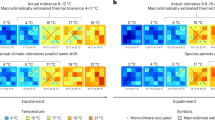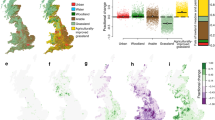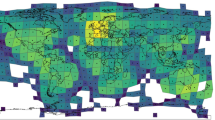Abstract
Many attempts to predict the biotic responses to climate change rely on the ‘climate envelope’ approach1,2,3, in which the current distribution of a species is mapped in climate-space and then, if the position of that climate-space changes, the distribution of the species is predicted to shift accordingly4,5,6. The flaw in this approach is that distributions of species also reflect the influence of interactions with other species7,8,9,10, so predictions based on climate envelopes may be very misleading if the interactions between species are altered by climate change11. An additional problem is that current distributions may be the result of sources and sinks12, in which species appear to thrive in places where they really persist only because individuals disperse into them from elsewhere13,14. Here we use microcosm experiments on simple but realistic assemblages to show how misleading the climate envelope approach can be. We show that dispersal and interactions, which are important elements of population dynamics15, must be included in predictions of biotic responses to climate change.
This is a preview of subscription content, access via your institution
Access options
Subscribe to this journal
Receive 51 print issues and online access
$199.00 per year
only $3.90 per issue
Buy this article
- Purchase on Springer Link
- Instant access to full article PDF
Prices may be subject to local taxes which are calculated during checkout





Similar content being viewed by others
References
Jeffree, E. P. & Jeffree, C. E. Redistribution of the potential geographic ranges of Mistletoe and Colorado Beetle in Europe in response to the temperature component of climate change. Funct. Ecol. 10, 562–577 (1996).
Porter, J. in Insects in a Changing Environment (eds Harrington, R. & Stork, N. E.) 93–123 (Academic, London, (1995)).
Sutherst, R. W., Maywald, G. F. & Skarrat, D. B. in Insects in a Changing Environment (eds Harrington, R. & Stork, N. E.) 59–91 (Academic, London, (1995)).
Beerling, D. J. The impact of temperature on the northern distribution limits of the introduced species Fallopia japonica and Impatiens glandulifera in north-west Europe. J. Biogeog. 20, 45–53 (1993).
Rogers, D. J. & Randolph, S. E. Distribution of tsetse and ticks in Africa: past, present and future. Parasitol. Today 9, 266–271 (1993).
Scott, D. & Poynter, M. Upper temperature limits for trout in New Zealand and climate change. Hydrobiology 222, 147–151 (1991).
Connell, J. H. The influence of competition and other factors on the distribution of the barnacle Chthamalus stellatus. Ecology 40, 49–78 (1961).
LaSalle, J. in Hymenoptera and Biodiversity (eds LaSalle, J. & Gauld, I. D.) 197–215 (CAB International, Wallingford, (1993)).
Lawton, J. H. & Hassell, M. P. in Ecological Entomology (eds Huffaker, C. B. & Rabb, R. L.) 451–420 (John Wiley, Chichester, (1984)).
Paine, R. T. Food web complexity and species diversity. Am. Nat. 100, 65–75 (1966).
Graham, R. W. in Global Warming and Biological Diversity (eds Peters, R. L. & Lovejoy, T. E.) 76–87 (Yale Univ. Press, New Haven, CT, (1992)).
Pulliam, H. R. Sources, sinks and population regulation. Am. Nat. 132, 652–661 (1988).
Rodriguez, J., Jordano, D. & Fernandez Haegar, J. Spatial heterogeneity in a butterfly-host plant interaction. J. Anim. Ecol. 63, 31–38 (1994).
Watkinson, A. R. On the abundance of plants along an environmental gradient. J. Ecol. 73, 569–578 (1985).
Pacala, S. W. & Hurtt, G. C. in Biotic Interactions and Global Change (eds Kareiva, P. M., Kingsolver, J. G. & Huey, R. B.) 57–74 (Sinauer, Boston, MA, (1993)).
Nordlander, G. Revision of the genus Leptopilina Forster, 1869, with notes on the status of some other genera (Hymenoptera, Cynipoidea: Eucoilidae). Entomol. Scand. 11, 428–453 (1980).
Wheeler, M. R. in The Genetics and Biology of Drosophila Vol. 3a (eds Ashburner, M., Carson, H. & Thompson, J. N.) 1–98 (Academic, London, (1986)).
Kraaijeveld, A. R. & van Alphen, J. J. M. Geographical variation in encapsulation ability of Drosophila melanogaster larvae and evidence for parasitoid-specific components. Evol. Ecol. 9, 10–17 (1995).
Bennetts, D. A. in Insects in a Changing Environment (eds Harrington, R. & Stork, N. E.) 49–58 (Academic, London, (1995)).
Coope, G. R. in Insects in a Changing environment (eds Harrington, R. & Stork, N. E.) 30–48 (Academic, London, (1995)).
Davis, M. B. in Community Ecology (eds Diamond, J. & Case, T. J.) 269–284 (Harper & Row, New York, (1986)).
Graham, R. W. et al. Spatial responses of mammals to late quaternary environmental fluctuations. Science 272, 1601–1606 (1996).
Valentine, J. W. & Jablonski, D. in Species Diversity in Ecological Communities (eds Ricklefs, R. E. & Schluter, D.) 341–349 (Univ. Chicago Press, (1993)).
Holt, R. D. & Lawton, J. H. The ecological consequences of shared natural enemies. Annu. Rev. Ecol. Syst. 25, 495–520 (1994).
Hanski, I. A. & Gilpin, M. E. (eds) Metapopulation Biology: Ecology, Genetics and Evolution (Academic, San Diego, (1997)).
Brussard, P. Geographic patterns and environmental gradients: the central-marginal model in Drosophila revisited. Annu. Rev. Ecol. Syst. 15, 25–64 (1984).
Parmesan, C. Climate and species' range. Nature 382, 765–766 (1996).
Acknowledgements
This work was funded by BBSRC under the Biological Adaptation to Global Environmental Change programme.
Author information
Authors and Affiliations
Corresponding author
Rights and permissions
About this article
Cite this article
Davis, A., Jenkinson, L., Lawton, J. et al. Making mistakes when predicting shifts in species range in response to global warming. Nature 391, 783–786 (1998). https://doi.org/10.1038/35842
Received:
Accepted:
Issue Date:
DOI: https://doi.org/10.1038/35842
This article is cited by
-
Defining the roles of local precipitation and anthropogenic water sources in driving the abundance of Aedes aegypti, an emerging disease vector in urban, arid landscapes
Scientific Reports (2024)
-
Interspecific interactions alter the metabolic costs of climate warming
Nature Climate Change (2023)
-
Projected ocean acidification and seasonal temperature alter the behaviour and growth of a range extending tropical fish
Coral Reefs (2023)
-
Climate warming exacerbates plant disease through enhancing commensal interaction of co-infested insect vectors
Journal of Pest Science (2023)
-
It is about time: effects of thermal fluctuations resulting from climate change on trophic interactions with a focus on host–parasitoid interactions
Evolutionary Ecology (2023)
Comments
By submitting a comment you agree to abide by our Terms and Community Guidelines. If you find something abusive or that does not comply with our terms or guidelines please flag it as inappropriate.



